2017 NISSAN LEAF air condition
[x] Cancel search: air conditionPage 129 of 424
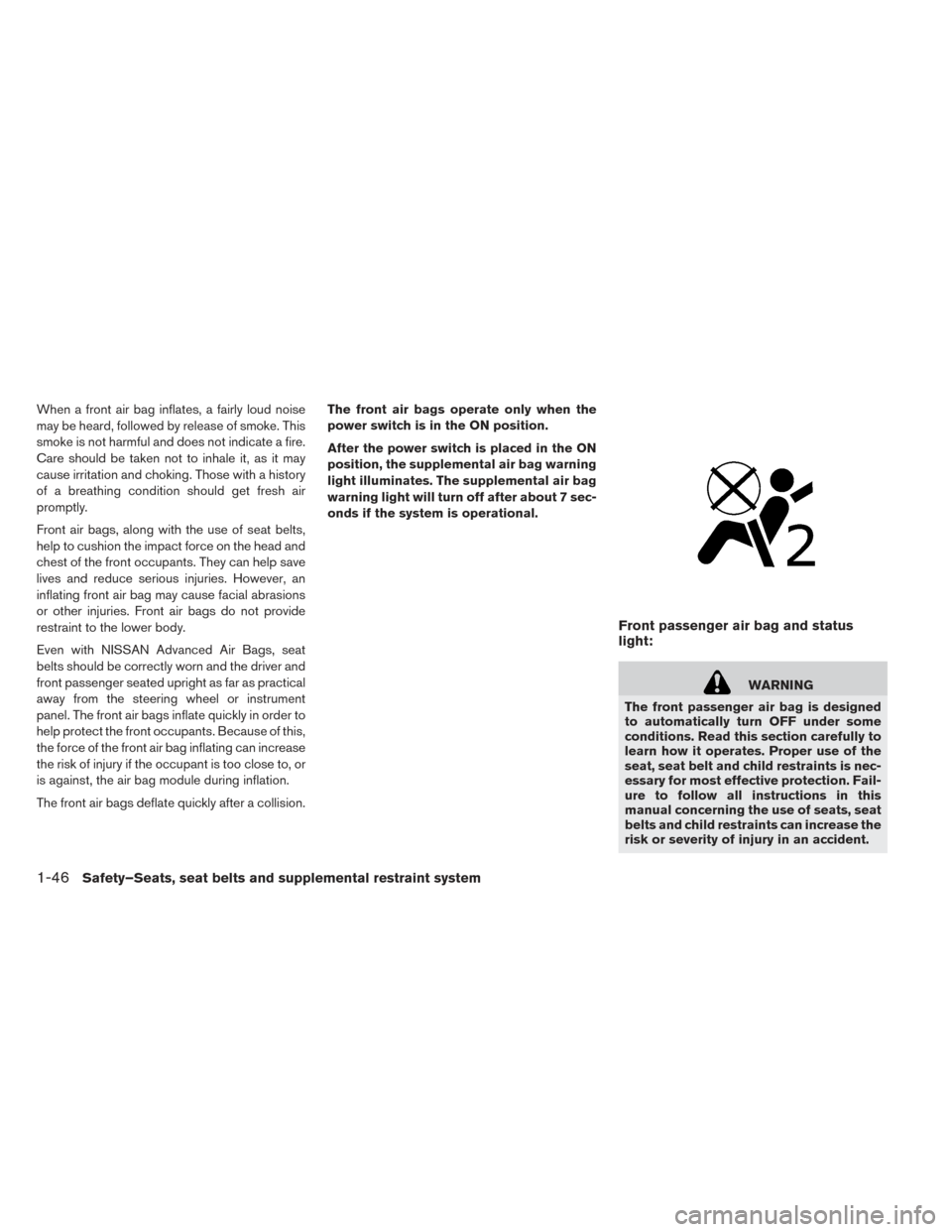
When a front air bag inflates, a fairly loud noise
may be heard, followed by release of smoke. This
smoke is not harmful and does not indicate a fire.
Care should be taken not to inhale it, as it may
cause irritation and choking. Those with a history
of a breathing condition should get fresh air
promptly.
Front air bags, along with the use of seat belts,
help to cushion the impact force on the head and
chest of the front occupants. They can help save
lives and reduce serious injuries. However, an
inflating front air bag may cause facial abrasions
or other injuries. Front air bags do not provide
restraint to the lower body.
Even with NISSAN Advanced Air Bags, seat
belts should be correctly worn and the driver and
front passenger seated upright as far as practical
away from the steering wheel or instrument
panel. The front air bags inflate quickly in order to
help protect the front occupants. Because of this,
the force of the front air bag inflating can increase
the risk of injury if the occupant is too close to, or
is against, the air bag module during inflation.
The front air bags deflate quickly after a collision.The front air bags operate only when the
power switch is in the ON position.
After the power switch is placed in the ON
position, the supplemental air bag warning
light illuminates. The supplemental air bag
warning light will turn off after about 7 sec-
onds if the system is operational.
Front passenger air bag and status
light:
WARNING
The front passenger air bag is designed
to automatically turn OFF under some
conditions. Read this section carefully to
learn how it operates. Proper use of the
seat, seat belt and child restraints is nec-
essary for most effective protection. Fail-
ure to follow all instructions in this
manual concerning the use of seats, seat
belts and child restraints can increase the
risk or severity of injury in an accident.
1-46Safety–Seats, seat belts and supplemental restraint system
Page 130 of 424
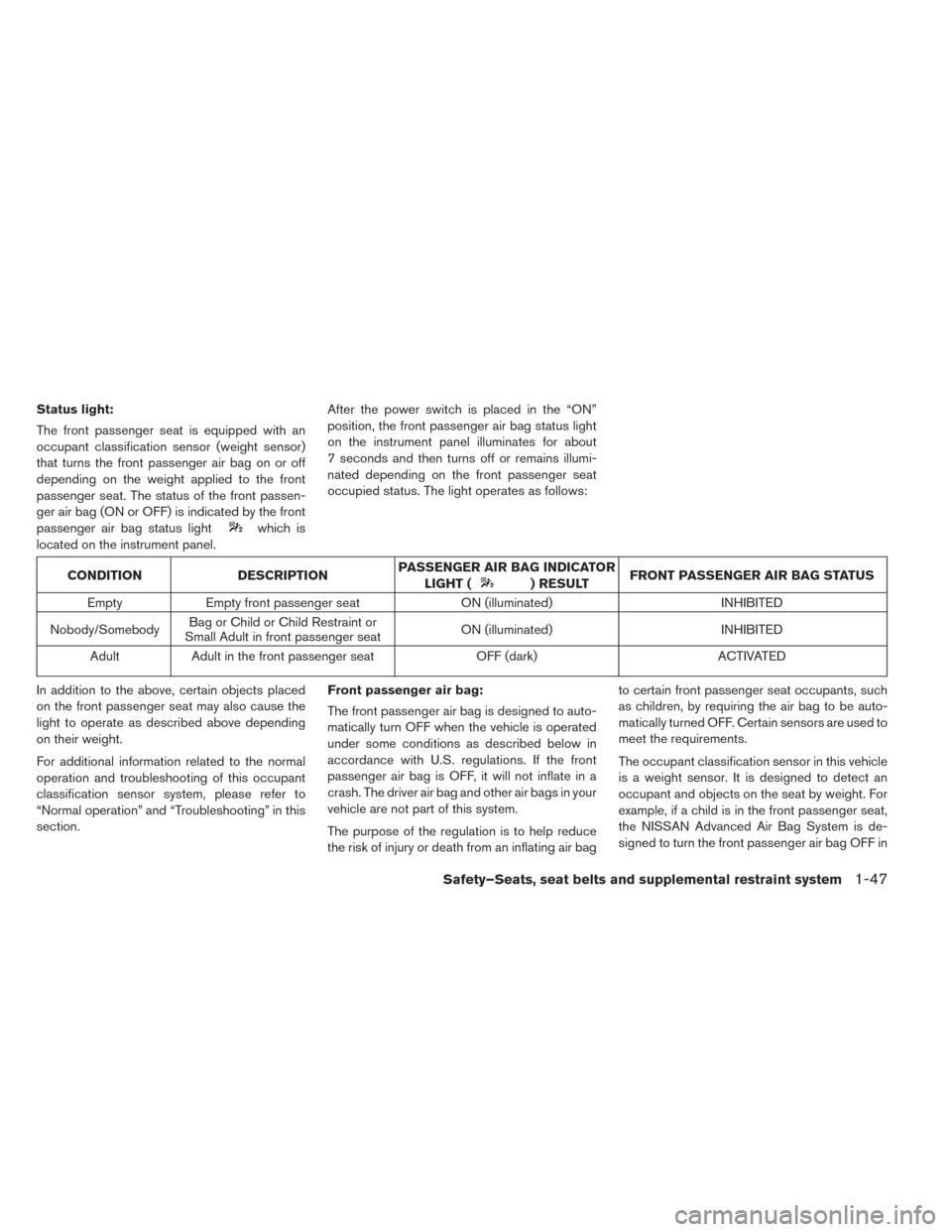
Status light:
The front passenger seat is equipped with an
occupant classification sensor (weight sensor)
that turns the front passenger air bag on or off
depending on the weight applied to the front
passenger seat. The status of the front passen-
ger air bag (ON or OFF) is indicated by the front
passenger air bag status light
which is
located on the instrument panel. After the power switch is placed in the “ON”
position, the front passenger air bag status light
on the instrument panel illuminates for about
7 seconds and then turns off or remains illumi-
nated depending on the front passenger seat
occupied status. The light operates as follows:
CONDITION
DESCRIPTIONPASSENGER AIR BAG INDICATOR
LIGHT () RESULT FRONT PASSENGER AIR BAG STATUS
Empty Empty front passenger seat ON (illuminated) INHIBITED
Nobody/Somebody Bag or Child or Child Restraint or
Small Adult in front passenger seat ON (illuminated)
INHIBITED
Adult Adult in the front passenger seat OFF (dark)ACTIVATED
In addition to the above, certain objects placed
on the front passenger seat may also cause the
light to operate as described above depending
on their weight.
For additional information related to the normal
operation and troubleshooting of this occupant
classification sensor system, please refer to
“Normal operation” and “Troubleshooting” in this
section. Front passenger air bag:
The front passenger air bag is designed to auto-
matically turn OFF when the vehicle is operated
under some conditions as described below in
accordance with U.S. regulations. If the front
passenger air bag is OFF, it will not inflate in a
crash. The driver air bag and other air bags in your
vehicle are not part of this system.
The purpose of the regulation is to help reduce
the risk of injury or death from an inflating air bagto certain front passenger seat occupants, such
as children, by requiring the air bag to be auto-
matically turned OFF. Certain sensors are used to
meet the requirements.
The occupant classification sensor in this vehicle
is a weight sensor. It is designed to detect an
occupant and objects on the seat by weight. For
example, if a child is in the front passenger seat,
the NISSAN Advanced Air Bag System is de-
signed to turn the front passenger air bag OFF in
Safety–Seats, seat belts and supplemental restraint system1-47
Page 131 of 424
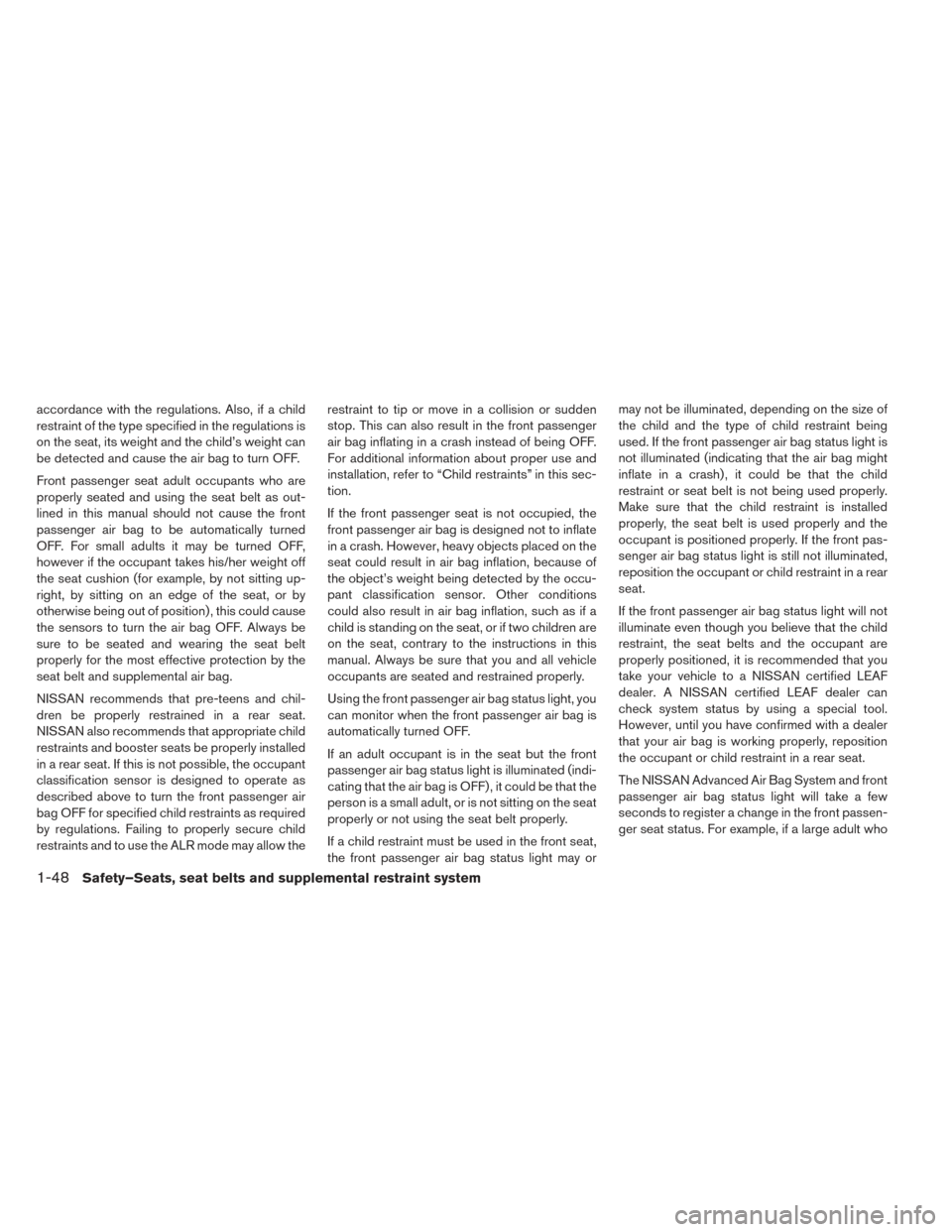
accordance with the regulations. Also, if a child
restraint of the type specified in the regulations is
on the seat, its weight and the child’s weight can
be detected and cause the air bag to turn OFF.
Front passenger seat adult occupants who are
properly seated and using the seat belt as out-
lined in this manual should not cause the front
passenger air bag to be automatically turned
OFF. For small adults it may be turned OFF,
however if the occupant takes his/her weight off
the seat cushion (for example, by not sitting up-
right, by sitting on an edge of the seat, or by
otherwise being out of position) , this could cause
the sensors to turn the air bag OFF. Always be
sure to be seated and wearing the seat belt
properly for the most effective protection by the
seat belt and supplemental air bag.
NISSAN recommends that pre-teens and chil-
dren be properly restrained in a rear seat.
NISSAN also recommends that appropriate child
restraints and booster seats be properly installed
in a rear seat. If this is not possible, the occupant
classification sensor is designed to operate as
described above to turn the front passenger air
bag OFF for specified child restraints as required
by regulations. Failing to properly secure child
restraints and to use the ALR mode may allow therestraint to tip or move in a collision or sudden
stop. This can also result in the front passenger
air bag inflating in a crash instead of being OFF.
For additional information about proper use and
installation, refer to “Child restraints” in this sec-
tion.
If the front passenger seat is not occupied, the
front passenger air bag is designed not to inflate
in a crash. However, heavy objects placed on the
seat could result in air bag inflation, because of
the object’s weight being detected by the occu-
pant classification sensor. Other conditions
could also result in air bag inflation, such as if a
child is standing on the seat, or if two children are
on the seat, contrary to the instructions in this
manual. Always be sure that you and all vehicle
occupants are seated and restrained properly.
Using the front passenger air bag status light, you
can monitor when the front passenger air bag is
automatically turned OFF.
If an adult occupant is in the seat but the front
passenger air bag status light is illuminated (indi-
cating that the air bag is OFF) , it could be that the
person is a small adult, or is not sitting on the seat
properly or not using the seat belt properly.
If a child restraint must be used in the front seat,
the front passenger air bag status light may ormay not be illuminated, depending on the size of
the child and the type of child restraint being
used. If the front passenger air bag status light is
not illuminated (indicating that the air bag might
inflate in a crash) , it could be that the child
restraint or seat belt is not being used properly.
Make sure that the child restraint is installed
properly, the seat belt is used properly and the
occupant is positioned properly. If the front pas-
senger air bag status light is still not illuminated,
reposition the occupant or child restraint in a rear
seat.
If the front passenger air bag status light will not
illuminate even though you believe that the child
restraint, the seat belts and the occupant are
properly positioned, it is recommended that you
take your vehicle to a NISSAN certified LEAF
dealer. A NISSAN certified LEAF dealer can
check system status by using a special tool.
However, until you have confirmed with a dealer
that your air bag is working properly, reposition
the occupant or child restraint in a rear seat.
The NISSAN Advanced Air Bag System and front
passenger air bag status light will take a few
seconds to register a change in the front passen-
ger seat status. For example, if a large adult who
1-48Safety–Seats, seat belts and supplemental restraint system
Page 132 of 424
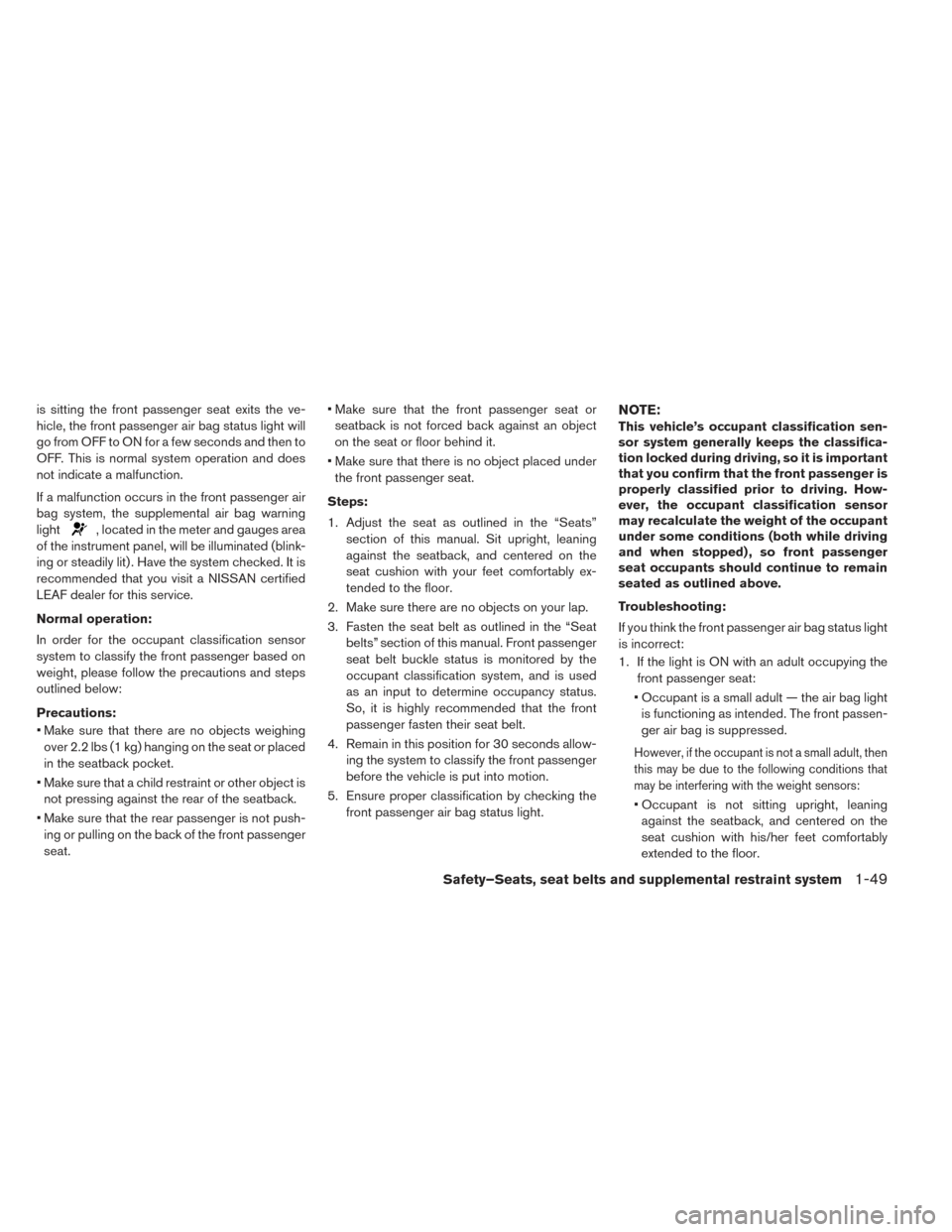
is sitting the front passenger seat exits the ve-
hicle, the front passenger air bag status light will
go from OFF to ON for a few seconds and then to
OFF. This is normal system operation and does
not indicate a malfunction.
If a malfunction occurs in the front passenger air
bag system, the supplemental air bag warning
light
, located in the meter and gauges area
of the instrument panel, will be illuminated (blink-
ing or steadily lit) . Have the system checked. It is
recommended that you visit a NISSAN certified
LEAF dealer for this service.
Normal operation:
In order for the occupant classification sensor
system to classify the front passenger based on
weight, please follow the precautions and steps
outlined below:
Precautions:
• Make sure that there are no objects weighing over 2.2 lbs (1 kg) hanging on the seat or placed
in the seatback pocket.
• Make sure that a child restraint or other object is not pressing against the rear of the seatback.
• Make sure that the rear passenger is not push- ing or pulling on the back of the front passenger
seat. • Make sure that the front passenger seat or
seatback is not forced back against an object
on the seat or floor behind it.
• Make sure that there is no object placed under the front passenger seat.
Steps:
1. Adjust the seat as outlined in the “Seats” section of this manual. Sit upright, leaning
against the seatback, and centered on the
seat cushion with your feet comfortably ex-
tended to the floor.
2. Make sure there are no objects on your lap.
3. Fasten the seat belt as outlined in the “Seat belts” section of this manual. Front passenger
seat belt buckle status is monitored by the
occupant classification system, and is used
as an input to determine occupancy status.
So, it is highly recommended that the front
passenger fasten their seat belt.
4. Remain in this position for 30 seconds allow- ing the system to classify the front passenger
before the vehicle is put into motion.
5. Ensure proper classification by checking the front passenger air bag status light.
NOTE:
This vehicle’s occupant classification sen-
sor system generally keeps the classifica-
tion locked during driving, so it is important
that you confirm that the front passenger is
properly classified prior to driving. How-
ever, the occupant classification sensor
may recalculate the weight of the occupant
under some conditions (both while driving
and when stopped) , so front passenger
seat occupants should continue to remain
seated as outlined above.
Troubleshooting:
If you think the front passenger air bag status light
is incorrect:
1. If the light is ON with an adult occupying thefront passenger seat:
• Occupant is a small adult — the air bag light is functioning as intended. The front passen-
ger air bag is suppressed.
However, if the occupant is not a small adult, then
this may be due to the following conditions that
may be interfering with the weight sensors:
• Occupant is not sitting upright, leaningagainst the seatback, and centered on the
seat cushion with his/her feet comfortably
extended to the floor.
Safety–Seats, seat belts and supplemental restraint system1-49
Page 133 of 424
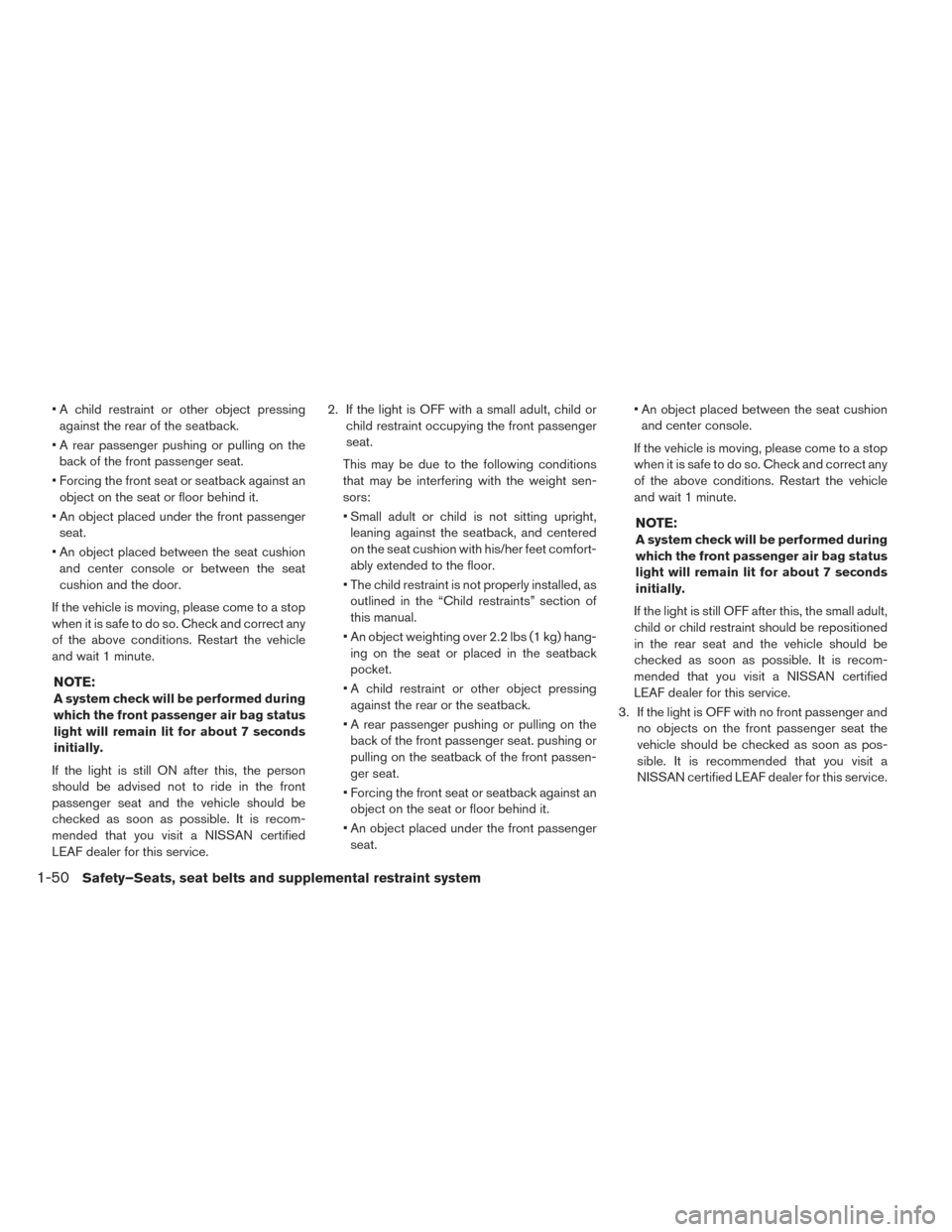
• A child restraint or other object pressingagainst the rear of the seatback.
• A rear passenger pushing or pulling on the back of the front passenger seat.
• Forcing the front seat or seatback against an object on the seat or floor behind it.
• An object placed under the front passenger seat.
• An object placed between the seat cushion and center console or between the seat
cushion and the door.
If the vehicle is moving, please come to a stop
when it is safe to do so. Check and correct any
of the above conditions. Restart the vehicle
and wait 1 minute.
NOTE:
A system check will be performed during
which the front passenger air bag status
light will remain lit for about 7 seconds
initially.
If the light is still ON after this, the person
should be advised not to ride in the front
passenger seat and the vehicle should be
checked as soon as possible. It is recom-
mended that you visit a NISSAN certified
LEAF dealer for this service. 2. If the light is OFF with a small adult, child or
child restraint occupying the front passenger
seat.
This may be due to the following conditions
that may be interfering with the weight sen-
sors:
• Small adult or child is not sitting upright, leaning against the seatback, and centered
on the seat cushion with his/her feet comfort-
ably extended to the floor.
• The child restraint is not properly installed, as outlined in the “Child restraints” section of
this manual.
• An object weighting over 2.2 lbs (1 kg) hang- ing on the seat or placed in the seatback
pocket.
• A child restraint or other object pressing against the rear or the seatback.
• A rear passenger pushing or pulling on the back of the front passenger seat. pushing or
pulling on the seatback of the front passen-
ger seat.
• Forcing the front seat or seatback against an object on the seat or floor behind it.
• An object placed under the front passenger seat. • An object placed between the seat cushion
and center console.
If the vehicle is moving, please come to a stop
when it is safe to do so. Check and correct any
of the above conditions. Restart the vehicle
and wait 1 minute.
NOTE:
A system check will be performed during
which the front passenger air bag status
light will remain lit for about 7 seconds
initially.
If the light is still OFF after this, the small adult,
child or child restraint should be repositioned
in the rear seat and the vehicle should be
checked as soon as possible. It is recom-
mended that you visit a NISSAN certified
LEAF dealer for this service.
3. If the light is OFF with no front passenger and no objects on the front passenger seat the
vehicle should be checked as soon as pos-
sible. It is recommended that you visit a
NISSAN certified LEAF dealer for this service.
1-50Safety–Seats, seat belts and supplemental restraint system
Page 137 of 424
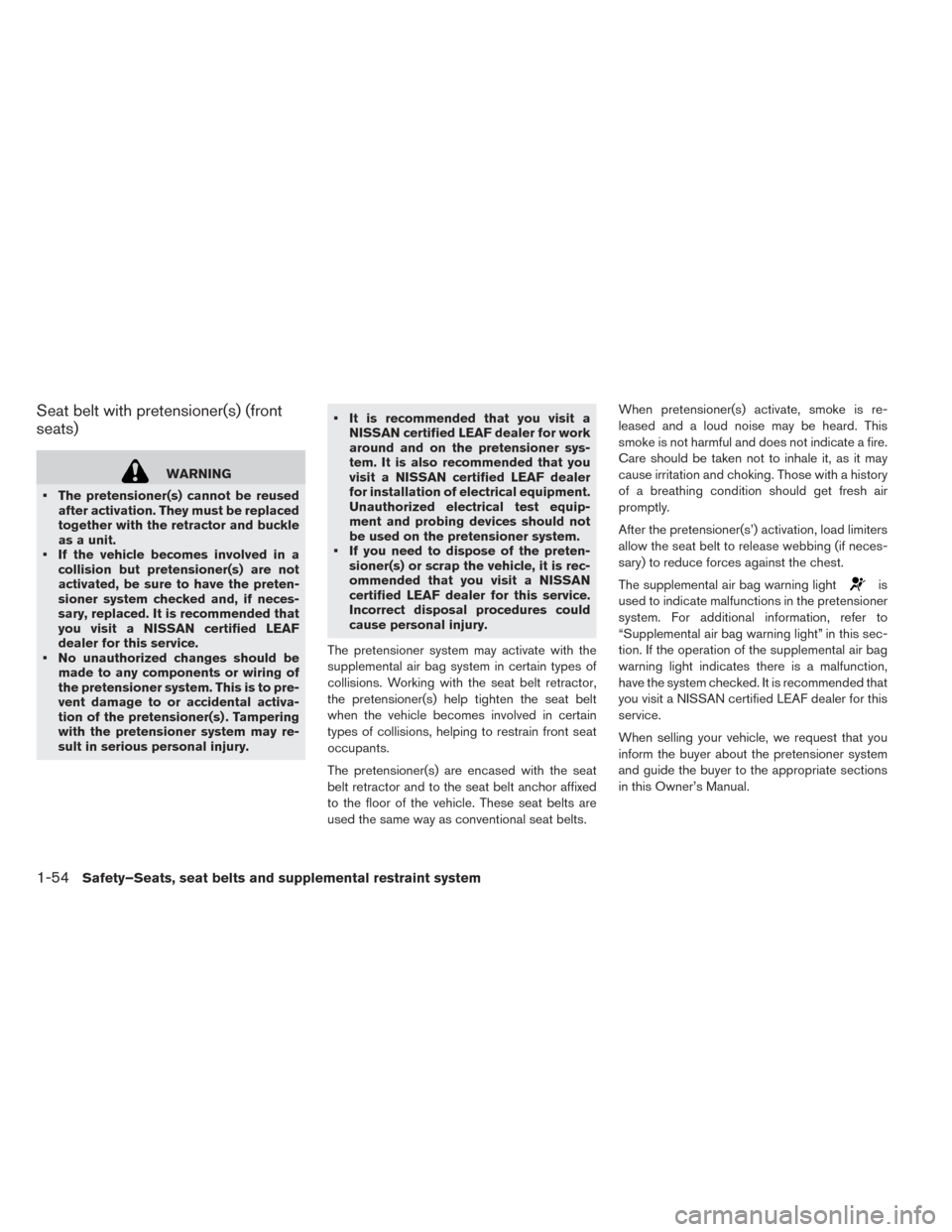
Seat belt with pretensioner(s) (front
seats)
WARNING
• The pretensioner(s) cannot be reused after activation. They must be replaced
together with the retractor and buckle
as a unit.
• If the vehicle becomes involved in a collision but pretensioner(s) are not
activated, be sure to have the preten-
sioner system checked and, if neces-
sary, replaced. It is recommended that
you visit a NISSAN certified LEAF
dealer for this service.
• No unauthorized changes should be made to any components or wiring of
the pretensioner system. This is to pre-
vent damage to or accidental activa-
tion of the pretensioner(s) . Tampering
with the pretensioner system may re-
sult in serious personal injury. • It is recommended that you visit a
NISSAN certified LEAF dealer for work
around and on the pretensioner sys-
tem. It is also recommended that you
visit a NISSAN certified LEAF dealer
for installation of electrical equipment.
Unauthorized electrical test equip-
ment and probing devices should not
be used on the pretensioner system.
• If you need to dispose of the preten- sioner(s) or scrap the vehicle, it is rec-
ommended that you visit a NISSAN
certified LEAF dealer for this service.
Incorrect disposal procedures could
cause personal injury.
The pretensioner system may activate with the
supplemental air bag system in certain types of
collisions. Working with the seat belt retractor,
the pretensioner(s) help tighten the seat belt
when the vehicle becomes involved in certain
types of collisions, helping to restrain front seat
occupants.
The pretensioner(s) are encased with the seat
belt retractor and to the seat belt anchor affixed
to the floor of the vehicle. These seat belts are
used the same way as conventional seat belts. When pretensioner(s) activate, smoke is re-
leased and a loud noise may be heard. This
smoke is not harmful and does not indicate a fire.
Care should be taken not to inhale it, as it may
cause irritation and choking. Those with a history
of a breathing condition should get fresh air
promptly.
After the pretensioner(s’) activation, load limiters
allow the seat belt to release webbing (if neces-
sary) to reduce forces against the chest.
The supplemental air bag warning light
is
used to indicate malfunctions in the pretensioner
system. For additional information, refer to
“Supplemental air bag warning light” in this sec-
tion. If the operation of the supplemental air bag
warning light indicates there is a malfunction,
have the system checked. It is recommended that
you visit a NISSAN certified LEAF dealer for this
service.
When selling your vehicle, we request that you
inform the buyer about the pretensioner system
and guide the buyer to the appropriate sections
in this Owner’s Manual.
1-54Safety–Seats, seat belts and supplemental restraint system
Page 138 of 424
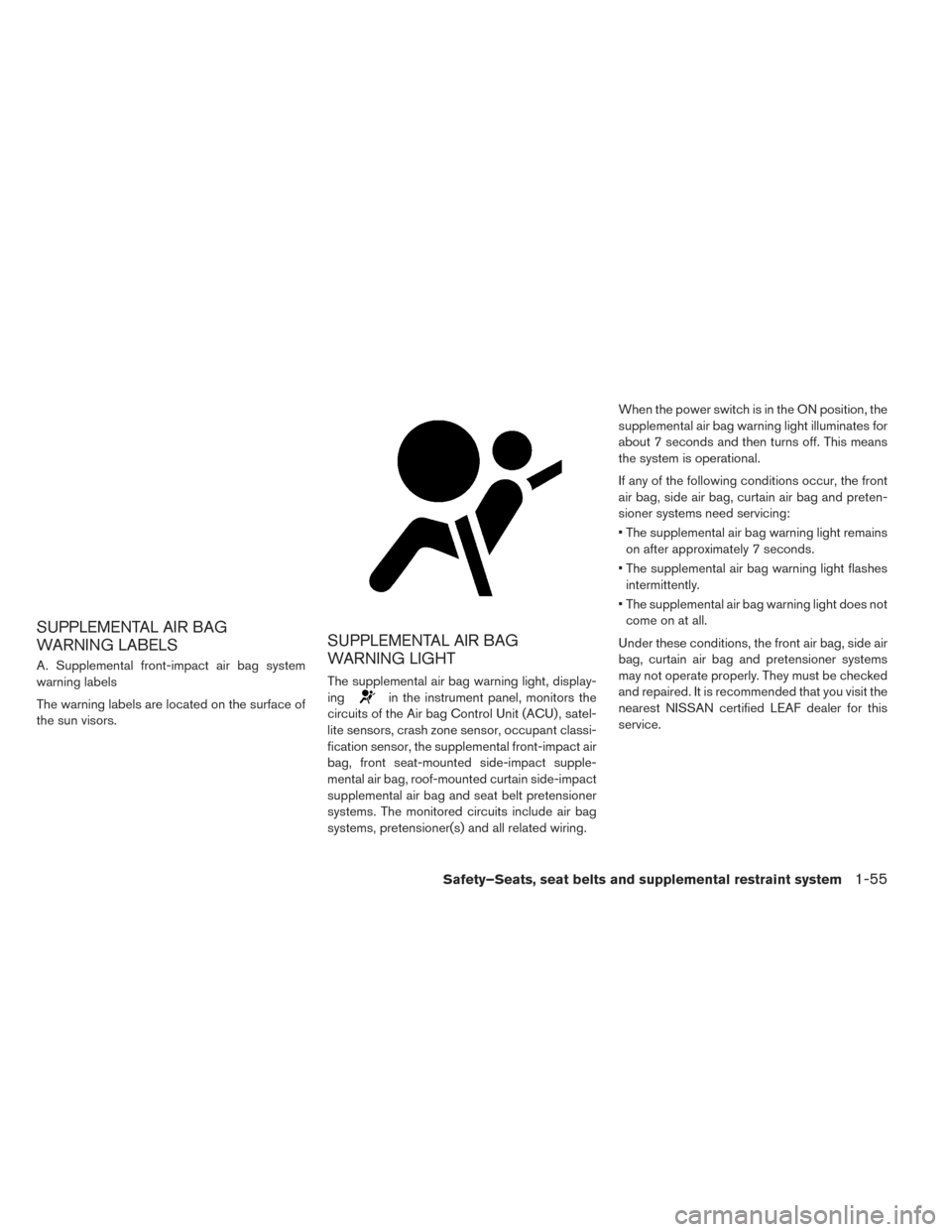
SUPPLEMENTAL AIR BAG
WARNING LABELS
A. Supplemental front-impact air bag system
warning labels
The warning labels are located on the surface of
the sun visors.
SUPPLEMENTAL AIR BAG
WARNING LIGHT
The supplemental air bag warning light, display-
ing
in the instrument panel, monitors the
circuits of the Air bag Control Unit (ACU) , satel-
lite sensors, crash zone sensor, occupant classi-
fication sensor, the supplemental front-impact air
bag, front seat-mounted side-impact supple-
mental air bag, roof-mounted curtain side-impact
supplemental air bag and seat belt pretensioner
systems. The monitored circuits include air bag
systems, pretensioner(s) and all related wiring. When the power switch is in the ON position, the
supplemental air bag warning light illuminates for
about 7 seconds and then turns off. This means
the system is operational.
If any of the following conditions occur, the front
air bag, side air bag, curtain air bag and preten-
sioner systems need servicing:
• The supplemental air bag warning light remains
on after approximately 7 seconds.
• The supplemental air bag warning light flashes intermittently.
• The supplemental air bag warning light does not come on at all.
Under these conditions, the front air bag, side air
bag, curtain air bag and pretensioner systems
may not operate properly. They must be checked
and repaired. It is recommended that you visit the
nearest NISSAN certified LEAF dealer for this
service.
Safety–Seats, seat belts and supplemental restraint system1-55
Page 143 of 424
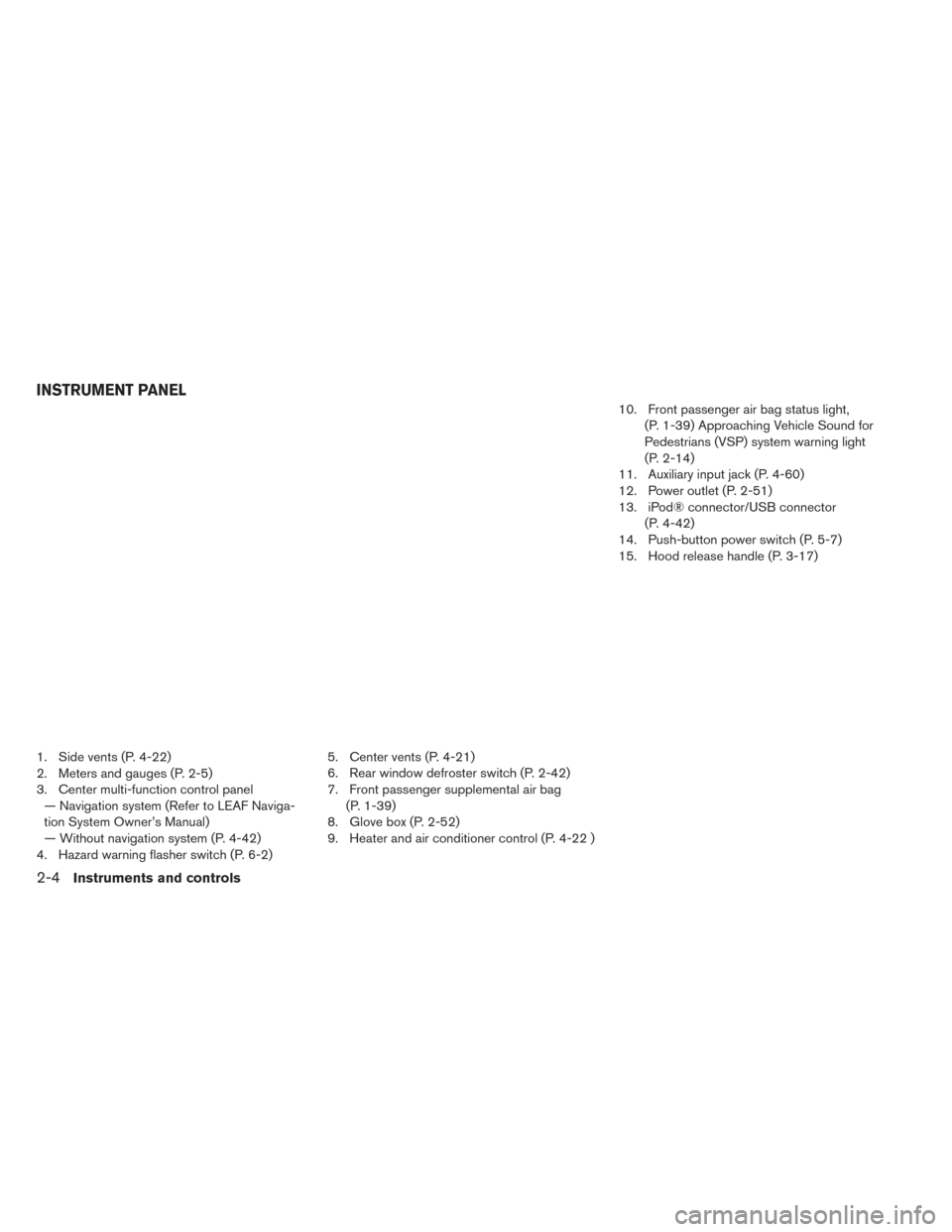
1. Side vents (P. 4-22)
2. Meters and gauges (P. 2-5)
3. Center multi-function control panel— Navigation system (Refer to LEAF Naviga-
tion System Owner’s Manual)
— Without navigation system (P. 4-42)
4. Hazard warning flasher switch (P. 6-2) 5. Center vents (P. 4-21)
6. Rear window defroster switch (P. 2-42)
7. Front passenger supplemental air bag
(P. 1-39)
8. Glove box (P. 2-52)
9. Heater and air conditioner control (P. 4-22 ) 10. Front passenger air bag status light,
(P. 1-39) Approaching Vehicle Sound for
Pedestrians (VSP) system warning light
(P. 2-14)
11. Auxiliary input jack (P. 4-60)
12. Power outlet (P. 2-51)
13. iPod® connector/USB connector (P. 4-42)
14. Push-button power switch (P. 5-7)
15. Hood release handle (P. 3-17)
INSTRUMENT PANEL
2-4Instruments and controls